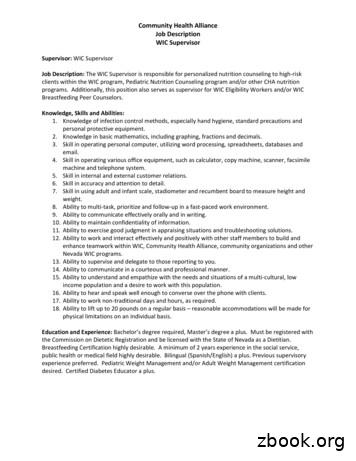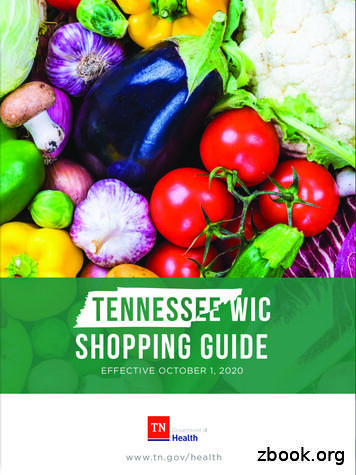WIC Case Study: Iowa
WIC Case Study: IowaKey TakeawaysThe Iowa WIC Program planned and implemented a statewide campaign to improve WIC accessby encouraging and supporting local WIC agencies in conducting certification appointmentsoutside of WIC sites. A statewide campaign effectively engaged local agencies in exploring ideas for providing WICservices outside of traditional WIC sites. Nine of the 20 local agencies implemented or arepreparing to implement WIC appointments at alternate locations; eight others are considering doing so. Webinar presentations and peer sharing calls with local agencies, hosted by the state agencyand Webster County WIC, were successful in sharing ideas, experiences, guidance, andresources and building interest in serving potential WIC participants in alternate locations. Individual calls with local agencies that were hesitant to try new approaches helped addressconcerns and encouraged them to join peer sharing calls or consider trying something newin the future. Agencies’ concerns included staffing, cooperation from communitypartners/providers, availability of space, and equipment needs. Collaboration between WIC agencies and community organizations and health care providersstrengthened existing relationships and contributed to success in serving participants atalternate locations. Four local agencies completed 457 appointments at alternate locationsover six months, including 361 certifications. Of those certified, 137 were new or formerparticipants. Updated certification policies, guidance, and other resources developed for the project willbe useful for statewide efforts to improve program access.WIC Agency ProfileThe Iowa WIC Program, administered by the Iowa Department of Public Health, serves 57,000participants through 20 local agencies, including 14 non-profit organizations and six localgovernment agencies. The local agencies operate in 150 WIC sites, providing services in all 99counties. The local agency partner, Webster County Public Health, provides services to 1,850participants in five counties.During 2018, Webster County Public Health worked with the Iowa WIC Program to conduct WICcertifications in conjunction with the agency’s Maternal and Child Health Home Visiting Program.Because Webster County Public Health provides integrated services, home visiting staff are trainedas Competent Professional Authorities to conduct nutrition assessment and certification during thehome visit. Participants provide income, address, and identification eligibility documents to WIC staffby text message, email, or fax.1
Project DescriptionStrategy 1- Implement a Statewide Campaign to Encourageand Support Local WIC Agencies in Completing Certificationsin Locations Outside of WIC SitesChallenge Many of Iowa’s counties are rural and many WIC families must travel a significantdistance to WIC sites. Additionally, local WIC agencies lack the staff resources tooperate full-time WIC clinics or offer certification appointments every weekday inall counties. To make WIC more accessible, Webster County Public Health workedwith the Iowa WIC program to include WIC certification in its home visitingprogram. Based on the success of this model, the state agency wanted to sharethis example of serving participants at alternate locations, along with policies andprocesses adapted for it, with local agencies throughout the state.Goal Assess local agency interest in, and concerns about, certification appointments atalternate locations and develop a presentation and toolkit to provide anticipatoryguidance.Strategy Iowa WIC shared the example of Webster County WIC’s integration of WICcertification with home visits and then surveyed local agencies to assess interestin conducting certifications at alternate locations and gather questions, concerns,and opportunities for doing this. Iowa WIC used survey responses to develop awebinar and toolkit to help local agencies consider potential locations forcertifications and pursue options in their communities.Outcome Of the 18 local agencies responding to the survey, seven said they were ready toexplore alternate locations, eight were not sure, and three said they were notready. After a webinar presentation on this topic (presented twice and with arecording available), nine agencies said they were ready to proceed and ten saidthey were not. The survey asked agencies to submit questions, concerns,anticipated barriers, and opportunities related to conducting certifications atalternate locations. Survey responses helped state agency staff understand theissues and prepare to address them, as well as to learn local agencies’ ideasabout potential locations. This information shaped the campaign and theimplementation guidance provided to local agencies.Local Agency Survey: Key Concerns About Offering Certification atAlternate Locations Staffing needed for caseload at current sites plus new locations Cost of purchasing and maintaining additional equipment or paying for use of space Internet connectivity and Wi-Fi security in locations outside of WIC office Doctor’s offices, libraries, food pantries, etc. don’t have room for a WIC clinic Developing timely, easy processes for obtaining required documents from participants Establishing relationships and/or gaining cooperation from other locations2
Strategy 2- Host Peer Sharing Calls For Local AgenciesInterested in Identifying Alternate Locations For WICcertificationsChallenge Distances between local agencies and lack of time for networking make it difficultto share ideas for making WIC more accessible. The state agency facilitated groupcalls to support peer-to-peer learning among agencies and identify newapproaches to certifying participants.Goal Facilitate the generation and sharing of ideas among local agencies, identifychallenges, and address questions related to conducting WIC certifications atalternate locations.Strategy The state agency and Webster County WIC facilitated six monthly peer sharingcalls with local agencies ready to proceed, providing a forum to discuss ideas andsteps needed to pursue them. The calls enabled local agencies to share theirexperiences and state agency staff to respond to questions and identify issues forfollow-up.Outcome The state agency hosted one peer sharing call per month between July andDecember 2019. Fifteen of the 20 local agencies participated in at least one call,six of which had responded they were not ready to consider alternate locations.State and local agency staff said the calls proved valuable, especially theopportunity for local agencies to share ideas and discuss considerations forimplementing them with their peers. Peer sharing calls helped local agenciesidentify various locations for conductingcertifications, including Federally QualifiedWIC Appointments Conducted atHealth Centers, hospitals,Alternate Locationswomen’s/homeless shelters, day caresettings, health care offices, Head StartTotal appointments: 457classrooms, Toys for Tots distributioncenters, and home visits.HealthupdatesBy the end of the project, four local5 (1%)agencies reported they had completed 457OtherWIC appointments at alternate locations17(4%)outside of their WIC site, including 361certifications, as well as nearly 100NutritionCertificationsnutrition education, health, or other types ofeducation361 (79%)WIC appointments. Webster County’s home74 (16%)visiting program accounted for more thanone-third (38.5 percent) of these, with threeother agencies conducting the rest. Of the families served during theseappointments, 94 were new to WIC, 43 were previous participants returning to theprogram, and 121 were already enrolled.Five other local agencies are planning to conduct WIC appointments at alternatelocations during 2020 and eight more are interested in doing so in 2021.3
Strategy 3- Conduct Individual Calls With Local AgenciesThat Indicated They Were Not Ready to ConductCertifications Outside of WIC Clinics to Discuss TheirConcerns and BarriersChallenge Staff of local agencies that indicated they were not ready to conduct certificationsat alternate locations might have been unclear about the project’s goals, availableoptions, or their agency’s capacity. For example, a common misconception wasthat the project’s goal was to expand WIC home visiting programs, which wouldnot have been feasible for most agencies.Goal Clarify the project and discuss their concerns or challenges with conductingcertifications at alternate locations.Strategy Schedule and conduct individual calls with 10 local agencies that responded theywere not interested or ready to conduct certifications at alternate locations. Thestate agency staff provided ideas and feedback to the local agencies during theindividual calls to help them better understand the goal and to address barriers orconcerns.Outcome State agency nutrition consultants conducted individual calls with eight localagencies during September and October 2019. One additional agency that hadresponded it was not ready decided to join a group peer sharing call rather thanschedule an individual call. Most of these agencies want to conduct certificationsat an alternate location by 2021.Iowa WIC Statewide CampaignSurvey local agencyinterest in providingservices in alternatelocationsHost monthly peersharing calls for ideasand supportPlan and presentwebinar and toolkitConduct individual callsto discuss local agencyconcernsLessons Learned1) For local agencies, building relationships with community organizations and providers is essentialto making WIC available at alternate locations. It is important to get buy-in from the organizationsand staff at these locations so they will encourage their clients to participate in WIC.2) Local agencies forged stronger relationships with health care providers and Head Start programsin their communities as a result of the project. When WIC services were integrated into healthcare delivery, provisional (temporary) certifications were rare, presumably because health carestaff reminded patients of information needed to certify for WIC. Head Start and WIC workedtogether to identify children on Head Start but not on WIC, with Head Start staff talking to thoseparents/caretakers about WIC rather than just sending information home.3) The local agency peer sharing calls were valuable in helping agencies think of new ways to makeWIC more accessible and easier to use. Local agencies became more optimistic about trying newideas and more willing to take part in future calls. Scheduling calls that all agencies can join waschallenging, however.4
4) Collecting data from local agencies on appointmentscompleted at alternate locations proved challenging eventhough the state agency provided a spreadsheet to capturethe data.“Providing services inlocations other than thetypical WIC clinic canhelp build strongerrelationships betweenlocal agencies andcommunity partnersand helps make WICservices moreaccessible toparticipants.”Next StepsWith the favorable response to the peer sharing calls, thefrequency of meetings with local agencies will be increased fromtwo per year to four and meetings will include time for localagencies to share ideas and experiences with streamlining WIC.The state agency will continue to encourage local agencies toidentify new locations for WIC services and to review and revisepolicies to reduce burden for participants and WIC staff whilemaintaining program integrity. The policies and processesdeveloped for this project, such as methods for participants tosubmit documents, helped Iowa WIC quickly implement remoteservices during the COVID-19 pandemic.Iowa WIC DirectorMFin archali 2ze 01d p 9:rojecAp t plSu ril anre rv 20de gar eye 19:ve din d llop g oced alte al agu rn geaM idan te l ncieacH ye a oca stigu eld 201ida we 9: nd r onses ;nc binoue a arrcesnd asnre dso diur strJuce ibSu nes uteto rve 20dga ye 19ug d :e i locnte alJu res aget ncH lyiesind eld - Deivi pe cedu er mal sh beca ari r 2lls ng 01;c a 9oll nd :ecteddataProject TimelineJFMAMJJASOProject TeamNNikki Davenport (lead)Iowa Department of Public Health WICnikki.davenport@idph.iowa.govTricia Nichols (lead)Webster County Public Healthtnichols@webstercountyia.org5D
WIC Case Study: Iowa Key Takeaways 1 WIC Agency Profile The Iowa WIC Program, administered by the Iowa Department of Public Health, serves 57,000 participants through 20 local agencies, including 14 non-profit organizations and six local government agencies. The local agencies operate in 150 WIC sites, providing services in all 99 counties.
Apr 04, 2014 · Documentation from WIC is required in both cases. Note: Any applicant who is categorically eligible for WIC, has a medical nutrition need, and is on Medicaid would be WIC-eligible in Iowa as all priority classes are being served. The table below lists the required conditions and documentation from WIC for Medicaid payment.
Lauren Hosterman, RD, LDN Nutrition Specialist, Maryland WIC Program . Agenda Origins, History and WIC Program Basics WIC Program Legislation Maryland WIC Foods Provision of Formula for Infants Maryland WIC Medical Docume
The MPSC WIC system will be a replacement for Nevada’s existing WIC Program operating certification system. It is the desire of the Nevada WIC Consortium to contract with a highly qualified and experienced contractor, who will transfer and implement the MPSC WIC SAM ng operatisystem to the Nevada te Sta and ITCN WIC Programs.
1. Serve as preceptor for the Nevada State WIC CPA training course. Observe WIC Eligibility Workers performing certifications and nutrition education appointments to ensure compliance with Nevada State WIC standards. 2. Assist staff in completing modules from the WIC learning management system and help them prepare for the State WIC exam. 3.
your WIC shopping trips. Your remaining balance and the date your current benefits expire will print near the bottom of the receipt each time you shop with your card. WIC SALES STEPS & TIPS WIC SALES STEPS 2. Know your PIN for using your TN WIC card. 3. Take your TN WIC Shopping Guide with you to the store. 4. Select your correct WIC-approved .
Ask the WIC customer to insert their WIC card into the POS terminal. Terminal validates the card and prompts for a pin number. Only the WIC customer can enter the pin number. WIC customer enters pin number and the Beginning WIC Food Balance Receipt prints showing the balance of WIC Cash Value Benefit (CVB) dollars the customer
Iowa Chapter, American Academy of Pediatrics Iowa Dental Association Iowa Department of Public Health Iowa Health Care Association Iowa Hospital Association Iowa Medical Society Iowa Nurses Association Iowa Pharmacy Association Iowa Veterinary Medical Association Iowa‘s Statewide Epidemiology Education and Consultation Program State Hygienic .
hydrate (C–S–H), ettringite, and Ca(OH) 2 through a hydration reaction in which hydration heat is produced within the concrete because of an exothermic reaction. Since the thermal cracking of concrete reduces its internal force, watertightness, and durability, an appropriate measure is required to control the heat of hydration. The factors that influence the hydration heat of concrete .























